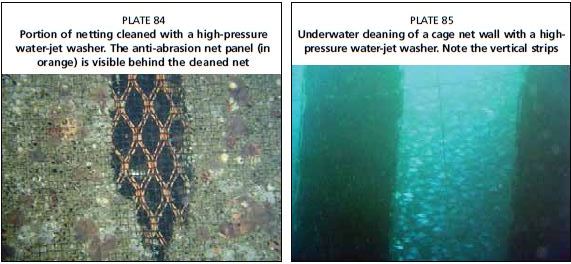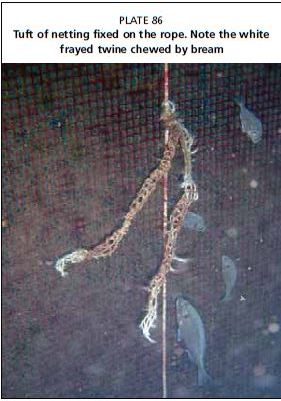BIOFOULING REMOVAL
Cleaning the mooring and grid lines
All the grid system lines need to be regularly cleaned of fouling organisms. Biofouling makes the structure heavier, stresses the lines, and affects the system's balance between weights, loads and buoys. To carry out this maintenance, a diver places a suitably sized shackle, tied to an auxiliary line, around the rope to be cleaned. The auxiliary line is attached to a small work boat, and as the boat moves along the line, the shackle runs along the line thereby stripping the larger fouling organisms.
This very simple technique can be used on all of the lines in the mooring system, including the lines and the mooring lines, extending down to the anchors.
Fouled netting with clogged mesh reduces water exchange inside the pen, and needs to be cleaned (Plate 84 and 85). The net is cleaned in order to maintain functionality if net replacement is not possible (see below).
A possible way to clean an installed net is to use a high-pressure water-jet washer. The cleaning is conducted by a diver who operates the cleaner gun underwater while the engine and compressor remain on the support vessel.
It is best if the diver cleans the net from the inside, flushing the biofouling outside of the pen with the water jet. Also, it is best practice to clean vertical strips as wide as the distance between two vertical lines. This allows for quicker cleaning of the net around the entire circumference, which ensures a quick recovery of water exchange through the cage.

There are several models of net cleaners with rotating discs, specifically designed for net cleaning, that can be operated from the surface. These types of washers reduce the time and labour of cleaning when compared with other standard models equipped with a gauge and nozzle and operated by divers.
Additional suggestions for net cleaning Grazing distraction devices
A significant reduction in the occurrence of holes in the net has been noted where objects designed for distracting the grazing activity of the fish are introduced into the cage. Good results have been obtained using ropes (8-12 mm in diameter x net wall length) where several tufts of netting are fixed along the rope length (approximately one tuft each metre) (Plate 86). The ropes are as long as the net wall, with the upper end of each rope tied onto the handrail, and the
lower end fixed with a plastic cable tie onto the lower part of the net wall. Alternatively, it can be weighted with a 2 kg dive weight tied onto the lower end of the rope. The number of ropes in each cage is half the number of stanchions (ie. one rope for every two stanchions).
The tufts of netting act as attractors for grazing fish, and this reduces the fish grazing activity on the cage net and, consequently, the number of holes created by the fish.

Self-cleaning pipes
Cage collars, which are often used as walkways by workers, are also subjected to biofouling. Mussels and other sessile organisms settle on the submerged part of the pipes, while slippery algal biofouling is very common on the emergent portion of the pipes.
This fouling represents a threat both for workers, who can slip on the algae and fall, and for the nets, which can be abraded by the hard shells of invertebrates. Therefore, these pipes also need to be cleaned regularly.

An easy and effective way to clean these. pipes is to install rope rings around the pipes (Plate 87). These are rings made from a 20-30 mm diameter rope that is tied loosely around pipes. The rings are then moved along and around. the pipe by the wave action. Their movement counters the fouling settlement because the ropes continuously brush the pipes. One ring is needed for each pipe section between each bracket of the cage.